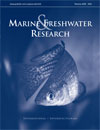Marine and Freshwater Research
Volume 65
Number 5 2014
This study focusses on integrated hydrological control to avoid water-quality impairment, such as algal blooms, in a regulated river ecosystem. We aimed at evaluating the mitigation of phytoplankton proliferation, which could be derived from ensemble effects between upriver dams and an estuarine barrage. The results stress that the optimal hydrological control by dams and a barrage control is effective to suppress algal blooms in a regulated river and evolutionary modelling is a good approach to determine the optimal criteria of dam and barrage discharges.
We present the first documented species of shark or ray in Australia to give birth to a two-headed offspring. Using magnetic resonance imagery (MRI), we found two parallel vertebral columns running the entire length of the offspring, diverging into two well formed heads. The cause of such births defects is unknown, although they may be linked to congenital and environmental stressors during embryonic development.
Understanding the biology of fish is vital to successful conservation and management, yet studying fish larvae in the wild is difficult due to their small size. This study found that marking of eastern rainbowfish larvae was possible by injecting their mothers with enriched stable barium and strontium isotopes. This technique will facilitate research on the movement of rainbowfish larvae in tropical stream networks.
Mapping benthic biodiversity is a key requirement for informed marine-zone management. This study demonstrated the value of a surrogacy approach to the prediction of infaunal biodiversity patterns on the tropical Carnarvon shelf of Western Australia. The predictive modelling approach facilitates an understanding of ecosystem processes in the region and contributes to integrated marine management.
Predictions about invasiveness and spread of a species are a complex issue. Here we test the physiological tolerances of native and non-native species to infer about their spread via estuarine bridges. We propose the use of multiple physiological tools to predict invasiveness, both for native and non-native species.
Bacterial influence on viable, benthic diatom assemblages was investigated using a novel approach involving the application of penicillin (antibiotic affecting diatoms only through bacteria). The results highlighted the spatial and seasonal variations in bacterial influence on diatom assemblages, and the crucial role of diatom assemblage composition in these interactions. This investigation provides a basis for future studies on the mechanisms underlying diatom-bacterial interactions in benthic environments.
To describe a food web structure is a main goal to understand ecosystem functioning. Here, we analysed the isotopic composition of primary producers and consumers in a large subtropical lake in southern Brazil. The combined analysis of isotopic signature and stomach content revealed a phylogenetically structured arrangement of fish species, indicating that main feeding niches are shared by taxonomically related species.
Culturally and recreationally important fisheries in intermittent rivers of northern Australia may be threatened by over fishing. This study explored whether fishing reduces the abundance large-bodied species and found that those targeted by both cultural and recreational fishers were less abundant in easily accessible, permanent waterholes. Using this evidence, river reaches potentially impacted by fishing can be identified and the effectiveness of traditional fisheries management strategies can be enhanced.




